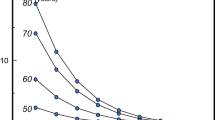Abstract
Background: Vitamin D deficiency may be more common in pre-menopausal women than previously thought and it may impair quality of life (QoL). Aim: The aim of this study is to evaluate QoL in pre-menopausal women with vitamin D deficiency and insufficiency. Subjects and methods: This is a cross-sectional study in which subjects were enrolled between September 1st and November 30th, 2011. Healthy pre-menopausal women with weakness, fatigue and non-specific pain were assigned into three groups according to their 25-hydroxyvitamin D (25-OHD) levels: ≤20 ng/ml (vitamin D deficient, no.=30), 21–29 ng/ml (vitamin D insufficient, no.=30) and ≥30 ng/ml (vitamin D sufficient, no.=20). Short form-36 (SF-36) scores, age, calcium (Ca), phosphorus (P), and PTH levels were compared among the groups and correlations of SF-36 scores with age, serum 25-OHD, Ca, P, and PTH were done. Results: There were significant differences among the groups with regard to PTH (p=0.008), physical component score (p=0.02), mental component score (p=0.035), physical functioning score (p=0.0001), and vitality score (p=0.05). Apart from PTH and physical functioning score, the results were significant when vitamin D-insufficient and -sufficient women were compared. Serum 25-OHD, but not PTH was correlated with some of the scales of SF-36. Conclusions: Some components of QoL are impaired not only in vitamin D deficient but also in insufficient pre-menopausal women, and impairment is related to 25-OHD rather than PTH levels.
Similar content being viewed by others
References
Adams JS, Hewison M. Update in vitamin D. J Clin Endocrinol Metab 2010, 95: 471–8.
Shinchuk LM, Holick MF. Vitamin D and rehabilitation: improving functional outcomes. Nutr Clin Pract 2007, 22: 297–304.
Holick MF, Binkley NC, Bischoff-Ferrari HA, et al. Evaluation, treatment, and prevention of vitamin D deficiency: an Endocrine Society clinical practice guideline. J Clin Endocrinol Metab 2011, 96: 1911–30.
Lips P, Hosking D, Lippuner K, et al. The prevalence of vitamin D inadequacy amongst women with osteoporosis: an international epidemiological investigation. J Intern Med 2006, 260: 245–54.
Forrest KYZ, Stuhldreher WL. Prevalence and correlates of vitamin D deficiency in US adults. Nutr Res 2011, 31: 48–54.
Nair R, Maseeh A. Vitamin D: the “sunshine” vitamin. J Pharmacol Pharmacother 2012, 3: 118–26.
Zamboni M, Zoico E, Tosoni P, et al. Relation between vitamin D, physical performance, and disability in elderly persons. J Gerontol A Biol Sci Med Sci 2002, 57: M7–11.
Bossola M, Ciciarelli C, Conte GL, Vulpio C, Luciani G, Tazza L. Correlates of depression and anxiety in chronic hemodialysis patients. Gen Hosp Psychiatry 2010, 32: 125–31.
Witham MD, Crighton LJ, Gillespie ND, Struthers AD, McMurdo MET. The effects of vitamin D supplementation on physical function and quality of life in older patients with heart failure: a randomized controlled trial. Circ Heart Fail 2010, 3: 195–201.
Anand S, Kaysen GA, Chertow GM, et al. Vitamin D deficiency, self-reported physcial activity and health-related quality of life: the Comprehensive Dialysis Study. Nephrol Dial Transplant 2011, 26: 3683–8.
Sakalli H, Arslan D, Yucel AE. The effect of oral and parenteral vitamin D supplementation in the elderly: a prospective, double-blinded, randomized, placebo-controlled study. Rheumatol Int 2012, 32: 2279–83.
Beck AT, Ward CH, Mendelson M, Mock J, Erbaugh J. An inventory for measuring depression. Arch Gen Psychiatry 1961, 4: 561–71.
Ware JE jr, Sherbourne CD. The MOS 36-item short-form health survey. I. Conceptual framework and item selection. Med Care 1992, 30: 473–83.
Kocyigit H, Aydemir O, Fisek G, Olmez N, Memis A. Validation and reliability of Turkish version of Short Form-36 (SF-36). Ilaçve Tedavi Dergisi (Drug and Treatment Journal) 1999, 12: 102–6 (In Turkish).
Ware JE jr, Gandek B, for the IQOLA Project. Overview of the SF-36 health survey and the International Quality of Life Assessment (IQOLA) Project. J Clin Epidemiol 1998, 51: 903–12.
Dawson-Hughes B, Heaney RP, Holick MF, Lips P, Meunier PJ, Vieth R. Estimates of optimal vitamin D status. Osteoporos Int 2005, 16: 713–6.
Kenny AM, Biskup B, Robbins B, Marcella G, Burleson JA. Effects of vitamin D supplementation on strength, physical function, and health perception in older, community-dwelling men. J Am Geriatr Soc 2003, 51: 1762–7.
Wicherts IS, van Schoor NM, Boeke AJP, et al. Vitamin D status predicts physical performance and its decline in older persons. J Clin Endocrinol Metab 2007, 92: 2058–65.
Houston DK, Cesari M, Ferruci L, et al. Association between vitamin D status and physical performance: The In CHIANTI Study. J Gerontol A Biol Sci Med Sci 2007, 62: 440–6.
Straube S, Moore RA, Derry S, McQuay HJ. Vitamin D and chronic pain. Pain 2009, 141: 10–3.
Landsdowne ATG, Provost SC. Vitamin D3 enhances mood in healthy subjects during winter. Psychopharmacology 1998, 135: 319–23.
Wilkins CH, Sheline YI, Roe CM, Birge SJ, Morris JC. Vitamin D deficiency is associated with low mood and worse cognitive performance in older adults. Am J Geriatr Psychiatry 2006, 14: 1032–40.
Lips P. Vitamin D deficiency and secondary hyperparathyroidism in the elderly: consequences for bone loss and fractures and therapeutic implications. Endocr Rev 2001, 22: 477–501.
McCarty MF. Secondary hyperparathyroidism promotes the acute phase response — a rationale for supplemental vitamin D in prevention of vascular events in the elderly. Med Hypotheses 2005, 64: 1022–6.
Sahota O, Gaynor K, Harwood RH, Hosking DJ. Hypovitaminosis D and ‘functional hypoparathyroidism’ — the NoNoF (Nottingham Neck of Femur) study. Age Ageing 2001, 30: 467–72.
Sahota O, Mundey MK, San P, Godber IM, Lawson N, Hosking DJ. The relationship between vitamin D and parathyroid hormone: calcium homeostasis, bone turnover, and bone mineral density, in postmenopausal women with established osteoporosis. Bone 2004, 35: 312–9.
Rejnmark L, Vestergaard P, Brot C, Mosekilde L. Parathyroid response to vitamin D insufficiency: relations to bone, body composition and lifestyle characteristics. Clin Endocrinol 2008, 69: 29–35.
Author information
Authors and Affiliations
Corresponding author
Rights and permissions
About this article
Cite this article
Ecemis, G.C., Atmaca, A. Quality of life is impaired not only in vitamin D deficient but also in vitamin D-insufficient pre-menopausal women. J Endocrinol Invest 36, 622–627 (2013). https://doi.org/10.3275/8898
Accepted:
Published:
Issue Date:
DOI: https://doi.org/10.3275/8898




